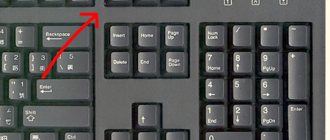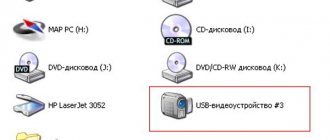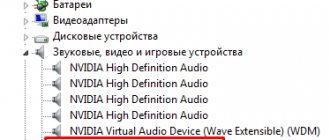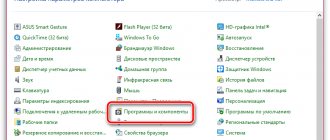Author: Andrey Fedorov
Last updated October 24, 2019
Touch screens have become widespread due to their convenience.
- 1 What is a touchscreen on a smartphone, and who invented it
- 2 What is a sensor and where is it used?
- 3 How the touchscreen works
- 4 Types of touch screens
- 5 How to calibrate the sensor (touchscreen)
- 6 The touchscreen does not work - how to determine it
- 7 Touchscreen and display: what is the difference
What is a touchscreen on a smartphone, and who invented it?
The term Touch Screen is formed from two English words. The first means “touch”, and the second means “screen”. This phrase fully conveys the operating principle of this type of display, which is to respond to the touch of a person’s fingers and perform certain actions. Despite the fact that this type of technology seems modern to us, the date of invention of the first touch screen is considered to be 1970. It was then that a university teacher from Kentucky, Samuel Hurst, was the first to decide to simplify the process of reading information from recorder tapes. The result of the scientist’s development was the appearance of the world’s first screen that supports touch input technology.
FOR YOUR INFORMATION!
The new product used the most primitive type of operation: a four-wire resistive method for determining the coordinates of the touch point.
The inventor of touch input is considered to be Samuel Hirst, a university professor who decided to simplify the process of reading information
The first devices to receive such an information input system were computers, and only in 1998 the first cell phone was born that used touch-sensitive typing. It was the brainchild of Alcatel. Next, Ericsson offered its version of a touchscreen in a mobile device. But these prototypes bore little resemblance to modern versions of touch screens.
The panel was monochrome, small in size and only allowed the user to dial a number. The first model where the touch screen acquired a modern shape was the communicator from HTC Qtek 1010/02 XDA, released in 2002. And the idea of using a touchscreen in mobile devices was brought to a qualitatively new level by Apple, which implemented the Multitouch feature or response to simultaneous touching of the screen with two or more fingers.
IMPORTANT!
The invention and mass implementation of touchscreens has brought a large number of positive aspects for the user and increased the ease of use of a smartphone. But this led to one significant drawback - the devices became more “delicate” and required careful handling, since damage to the glass could damage the entire sensor.
One of the areas of application of the touchscreen is graphics tablets, the use of which simplifies the process of creating animation
What is a touchscreen?
Many people ask: “What is the difference between a touch screen and a display or screen? Isn't this the same thing? No, they seem the same, but in fact they carry different meanings and functions, so I want to clarify certain points:
Display
Firstly, the display is the spare part that designs and reproduces the desired image. It displays the necessary information received by the owner of the device. If it is faulty, the problem is shown in the picture:
- lack of image;
- various interferences;
- clear or blurry lines;
- black spots and the like.
Touchscreen
Secondly, a touch screen is, in fact, a touch glass that works according to a simple scheme. When you touch it with your finger, it gives a command to perform various functions of the device.
@images.techhive.com
Correct interpretation of the elements significantly influences the further development of events on your device. This makes life easier not only for the user, but also for the technical service employee, for better troubleshooting if they occur.
What is a sensor and where is it used?
Modern people can no longer imagine their lives without devices that have touch input, this invention has become so firmly established in life. According to statistics, more than 90% of the entire population of the Earth has at least once encountered a touchscreen, which is used in a variety of electronic devices and gadgets:
- smartphones;
- tablets and tablet computers;
- banking or payment terminals;
- devices for purchasing electronic tickets;
- displays (computer, in refrigerators, household appliances).
The development of touch technology is not limited to mobile devices. There are developments where the touchscreen is embedded in large surface areas.
FOR YOUR INFORMATION!
Not long ago, a smart desk was announced, the surface of which is one large touchscreen. A similar tabletop can be used as a multimedia table. Also, a few years ago, an entire touch wall was introduced, by pressing any area of which you can call up various functions.
The interactive wall is a technology of the future that also uses a touchscreen
Some non-technical people wonder what a touchscreen on a tablet is and how it differs from a similar input device on a smartphone. The answer to this question is simple - nothing, since the principle of operation of the touch screen is similar, regardless of the device in which it is used.
Inexpensive and high-quality smartphones. In a special publication on our portal, we will talk in detail about low-cost touchscreen smartphones. You will find out whether a budget smartphone can be good: advantages and disadvantages, how to choose a smartphone based on parameters: display, memory, processor.
Distinctive characteristics of multi-touch from a conventional touch screen
These two screens should not be confused. An ordinary sensor reacts only to one touch ; the sequence of the process is of particular importance for it. Multi-touch screen control is based on several touches simultaneously.
Engineers from leading companies regularly develop new combinations that should make the operation and management of electronic devices easier. Smartphone owners have long felt the benefits of the zoom function. Many manufacturers claim that their gadgets are capable of recognizing from 10 to 20 touches simultaneously.
How does the touchscreen work?
To fully understand what a touchscreen on a phone is, you need to understand what the smartphone screen is made of and how the sensor works. The main elements of the touch screen are:
- A matrix consisting of a layer of liquid crystals. Similar display surface technology is used in a television or computer monitor.
- Microdiodes, which are located in the second layer under the matrix and serve to illuminate the working surface.
- Diodes located on the surface of the imaging layer, which are the main touch processing tool.
- Glass that covers the screen itself and prevents it from damage.
- Anti-glare coating prevents glare and allows you to comfortably look at the screen in sunny weather.
The simplest diagram of a touchscreen device
Based on how the touchscreen works, we can highlight a number of advantages and disadvantages of such a technology for dialogue between the user and an electronic device, which are divided into pros and cons for stationary devices and mobile equipment.
| pros | Minuses |
| Stationary devices | |
| Increased level of reliability. | Lack of tactile feedback. |
| High wear resistance, dust resistance and immunity to small impacts. | Placing the device at the level of the human body leads to hand fatigue during prolonged use. |
| A small keyboard may cause errors or typos. | |
| Mobile devices | |
| Easy to use. | Lack of tactile sensations. |
| Given the small size of the device itself, it is possible to create the largest possible screen. | Some matrices consume a large amount of energy when illuminated for a long time, which leads to the need for frequent charging. |
| Convenience of typing even large amounts of text. | Mechanical damage can lead to damage to the touchscreen. |
| There is an evolution of touch input technology, which leads to the emergence of qualitatively new devices with better capabilities every year. | Lack of the required level of hygiene. |
FOR YOUR INFORMATION!
Many manufacturers, especially stationary devices that use a touchscreen, due to their shortcomings, have taken the path of duplicating the ability to input with mechanical keys. This is necessary if the touch screen fails.
The sizes of modern touchscreens depend on the needs of the manufacturer and the device in which they will be used
Resistive touchscreen
Resistive touchscreens are budget touchscreens. They are usually equipped with inexpensive Chinese phones. The part consists of several transparent components, between which a conductive mesh is located. After touching, the circuit closes and a special electronic controller calculates the coordinates of the perfect press. Due to its design, the resistive screen can only process a single click.
The advantage of a resistive touchscreen is the ability to use any object to press. Previously, manufacturers even equipped phones with styluses for convenient selection of elements on the screen.
The disadvantage of resistive screens is their increased susceptibility to damage. The element cannot be made of hard material, so such touchscreens were constantly covered with scratches, chips and cracks. The situation was saved only by gluing a protective film on the surface of the sensor.
Types of touch screens
The general classification of touchscreens that are on the market involves dividing them into varieties based on type and design features. The most used are resistive and capacitive types, which are used in most mobile gadgets. There are also:
- matrix;
- infrared;
- projective capacitive;
- optical;
- DST sensors;
- wave;
- induction
The resistive sensor is considered “last century” due to imperfect technology
Resistive touch screen
When talking about what a Touch Screen is, the first thing we should mention is resistive screens, which were the first to be mass produced. Such screens consist of two transparent plates made of plastic, onto which a thin conductive mesh is applied. A dielectric layer is installed between the plates, which is required to sense the user pressing the desired area of the screen.
When the owner of the smartphone performs an action (for example, clicking on the desired area of the screen), the dielectric in this place moves apart, which leads to the contact of the two plates with each other. A current appears, which is registered by a special controller that determines the specific pressing point using a coordinate grid. Next, this data enters the processing program, which, according to a pre-created algorithm, performs the necessary action.
Special electrodes located at the corners of the matrix are responsible for determining the coordinates of the pressing point.
Resistive screens, in turn, are divided into two subtypes:
- Four-wire sensor . They are made from just one panel made of glass and a plastic membrane, onto which the resistive supply of the screen itself is applied. All free space between glass and plastic is filled with insulators. When you press, the circuit closes, which leads to the appearance of the coordinates of the point of contact.
- Five-wire . A distinctive feature of this type is the absence of resistive support for the membrane and the presence of a conductive layer. This provides greater reliability, since even after the matrix is damaged, it continues to work. The pressure point is tracked by the degree of change in membrane voltage.
FOR YOUR INFORMATION!
There are also eight-wire resistive screens that improve the accuracy of touch processing, but do not increase the reliability of this type of sensor.
The disadvantage of a resistive sensor is the lack of multi-touch support
Speaking about resistive touch screens, it should be noted their low cost, the ability to press with a finger, stylus, or even a gloved hand. The disadvantages include:
- low degree of conductivity of light rays;
- susceptibility to scratches and cracks due to impact;
- lack of multi-touch;
- short service life, which averages no more than 34 million clicks;
- the impossibility of implementing the function of sliding across the screen, since the resistive matrix only responds to pressing.
Capacitive touch screen
The modern type of matrix is a capacitive screen type. What it is? The essence of the work of this type is to follow the laws of elementary physics, namely the property of an object with a larger capacity to conduct alternating current.
Capacitive type operation is based on the rule of electrical potential difference
In terms of its design, this type of matrix is a glass plate, on the surface of which a layer of resistive material is applied.
FOR YOUR INFORMATION!
The best resistors in this case are alloys of indium oxide and tin oxide.
At the corners of the screen there are electrodes that apply a small voltage to the entire surface of the matrix. Upon contact with a person’s finger, a leak occurs, which is recorded by sensors and transmitted to the processing controller, which calculates the coordinates of the point of pressure. Distinctive features of this type of screen are a long service life, which is more than 200 million clicks, increased transparency, and the ability to impermeable to liquid. But the surface of this sensor still remains vulnerable to mechanical impact, so these types of matrix are used in stationary devices located in a place protected from external factors.
Most modern mobile devices use projected capacitive sensors
Projected capacitive sensors
Speaking about what a touch screen is, you should definitely note the type of matrix that is used in most modern smartphones and tablet computers. We are talking about a projective capacitive sensor. A design of this type is represented, in addition to the usual panel, by a grid of electrodes that are applied to the back side of the matrix. The existing electrodes, together with the human body, form a capacitor, and built-in electronics are required to measure the capacitance of the resulting system.
FOR YOUR INFORMATION!
One of the leaders in the production of screens, Samsung, managed to fit pressure-sensitive electrodes between sub-pixels, which simplified the design and increased transparency.
Increased transparency, the ability to use thick glass (up to 19 mm) - all this reduces the risk of damage to projection-capacitive screens, which is why they are installed in devices located in open areas.
In the infrared sensor, the principle of operation is to interrupt the IR rays at the point of contact
Matrix and infrared touch screens
Among the types of sensors, two not the most common types can be mentioned - matrix and infrared screens. Matrix designs work on the general principles of resistive designs, but their distinguishing feature is simplicity. Vertical conductive strips are applied to the membrane surface, and horizontal conductive strips are applied to the glass surface. When pressed, the strips come into contact, and the controller calculates the location of contact and determines the coordinates of the point. A significant disadvantage is the impossibility of ensuring high discreteness of the sensor due to the simplicity of the design.
Infrared types use a similar principle of intersecting stripes that represent infrared rays. When you touch the screen with any object, the grid of rays is interrupted at this point. This type is used on devices that require high image clarity, for example, e-books. The disadvantage of the IR sensor is its susceptibility to contamination.
Interactive maps use a strain gauge sensor type
Optical and strain gauge touch screens
The optical type is distinguished by the presence of infrared illumination, which is distributed between the glass and the matrix, and is capable of reflecting up to 100% of light within itself. When touched with a finger, dispersion occurs. The electronics just have to create a scattering pattern to determine the pressing point. This is done in the following ways:
- installing a camera next to the projector;
- introduction of an auxiliary subpixel.
Similar types of screens are used in interactive school boards. The strain gauge sensor is sensitive to screen surface deformation. This type is characterized by increased resistance to damage, so these matrices are used on ticket selling devices and ATMs.
DST technology works on the principle of recording piezoelectric manifestations inside a glass panel when pressed with a finger
DST touch screens
The basis of this type of operation is to capture the piezoelectric phenomenon in the glass panel. The main feature is the ability to respond to touch by any object and operate in any dusty conditions. For high-quality operation, the finger must be constantly in motion.
How does your smartphone's touchscreen actually work?
Rating of this article according to readers:
5
(28)
If you've been interested in how a touch screen works, you've most likely come across one of these "radio hobbyist" articles. They are all written like a carbon copy and sound something like this: when you touch the screen with your finger, at a certain point the capacitance of the conditional capacitor changes, which is registered by special sensors.
I have always been surprised by such explanations. The fact that someone replaced the words "touch screen" with the words "capacitor capacity" never made me feel better. Were all these “tech bloggers” former electricians? Why not explain such an interesting technology in simple words so that everything is clear?
Then I see the news that Apple has introduced the iPhone X with a 120 Hz screen, but this is not the image refresh rate (as on the Galaxy S20), but the frequency of some kind of sensor polling. Naturally, I go to the Internet for answers and see the same type of explanations: the iPhone X screen sensor processes finger movements 2 times faster, that is, reading occurs not in 16, but in 8 milliseconds!
Yeah, everything seems to be falling into place now. True, it is not entirely clear what other reading is, what it means to “process finger movement 2 times faster” and why the processor can process billions of operations per second, but finger movement only 60 or 120 times per second?
In general, this article will be different. After reading it, you will not be left with an unpleasant “aftertaste” and you will really understand how it all works and what 120 Hz has to do with it.
How the touch screen works - real drama at your fingertips!
So, first of all, it is important to understand that the smartphone screen itself is completely insensitive. No matter what or how we touch it, no reaction will follow. After all, this is a simple set of several million tiny colored light bulbs that a smartphone uses to display a picture.
To get some kind of reaction to touch, you need to additionally place a special “sensitive layer” somewhere. But what does it look like and how exactly does it work?
Let's imagine that we only need to make one small point on the screen touch sensitive. To do this, we will place two small plates above this point - orange and blue.
We will apply current to one plate, that is, drive a large number of electrons (negatively charged particles) there:
Nature always strives for balance, that is, inside a plate or anything (for example, our fingers) the number of positive and negative charges should be approximately the same.
However, on the orange plate there was an excess of electrons (negatively charged particles), which we pushed there by force, taking them from the smartphone battery. They try to push away from each other and join positively charged particles, but they cannot.
The fact is that we previously isolated these two plates from each other so that free electrons could not simply jump to the blue plate, where positively charged particles are eagerly awaiting them. The electric field of the orange plate continues to repel all the “minuses” and attract the “pluses”, of which there are already quite a lot of collected on the blue plate.
What happens if we touch these plates with any current-conducting object, for example, with our finger?
The electric field of the orange plate will instantly begin to act on our finger, partially “switching attention” from the positive charges of the blue area to the positive charges inside our finger:
After all, the blue plate is already filled to capacity with positively charged particles and this “pressure” is too high, but there is no “pressure” on the finger - both positive and negative charges “float” freely there. Naturally, all this will lead to the fact that there will be fewer positively charged particles on the blue plate, since the influence of the orange plate has decreased and switched to the finger.
That's basically it! All we have to do is measure these charges on the plate and we will immediately understand that an extra object has appeared near them - someone touched the screen.
In order for the entire screen to become sensitive, we need to completely cover it with these plates: first, the first layer to which we will apply current, then the second insulating layer and then the third, on which we will measure the change in charge:
Even though all these layers are right in front of your eyes and block the image, you won't see them because they are all made of completely transparent materials. For example, glass can be used as insulation, and the grids of conductive plates are made of indium tin oxide. In low-quality screens, it is still quite possible to see this grid if you look at the switched-off screen at an angle in the bright sun.
What is the sensor polling rate? Or where does the iPhone have 120 Hz?
In the picture above, I schematically showed meshes made of conductive material, but, naturally, I missed the size a little. Besides, I didn't talk about one important thing. All orange plates are connected in lines (rows), and blue ones are connected in columns. That is, in reality everything looks something like this:
Why do this? It is clear that the touch layer on the screen does not consist of 3 lines and 3 columns, but, for example, 80 lines and 40 columns, that is, a total of 3200 intersections, at which we analyze the electric field. Can you imagine what kind of circuit we need to make to connect each such electrode to its own power supply so that we can analyze 3200 areas on the screen?
Instead, we simply apply voltage to the entire row and column at once. That is, we connect only rows and columns, after which our diagram looks something like this:
But now a colossal problem arises! We turn on the voltage to the first layer so that an electric field is created around each intersection and begin to continuously monitor the change in the electric field in each column. Let me remind you once again that all electrodes (plates) are now connected in one column.
When we touch a specific point, the system instantly records the change in voltage not at a specific point, but in the whole column (in the picture it is the 7th column):
It turns out that the screen only understands that a touch occurred in a long strip, but where exactly - no idea, because we do not analyze each specific intersection of electrodes, but connect them all in columns and rows.
Is there any way to solve this problem? Yes, easily! Let's just stop applying voltage to the entire grid (the entire screen) and “push” free electrons only into the first row of conductive plates. As a result, an electric field will be created only along one single line.
Now, when the 7th column “works”, we will know for sure that the point of contact is at the intersection of the first row and the seventh column. Why is that? Yes, because in all the other lines there was no electric field at all, but we only supplied current to the first line.
Indeed, this solves the problem for the first line. But what about the rest? Similar! We apply voltage only to the first line and measure all columns, turn off the current on the first line and apply voltage to the second line. The columns measure the change continuously. So we just turn on each row one by one and check the columns. After we reach the last line, we go back to the first.
Of course, the electronics build a “touch map” to get a complete picture of where the fingers were located on the screen along all lines. After all, a finger is not a thin pen; it always covers a large area, that is, it changes the electric field (and capacitance) at several intersections at once. Therefore, the voltage values for each line are remembered.
One such cycle of passage from the first to the last line is 1 Hz. If the “sensor polling rate” was equal to one hertz, it would be extremely difficult to control such a screen, especially for gestures (moving a finger across the screen) or multi-touch (simultaneous touching of several fingers).
To do this, we speed up a little and the entire cycle from the first to the last row takes place in 16 milliseconds, that is, in 1 second we get 60 passes (alternately applying voltage from the first to the last row and reading the voltage on the columns).
Whether it is necessary to go through all the lines even faster is an interesting question. For example, the picture on the iPhone 11 screen changes every 16 milliseconds (that is, the screen refresh rate is 60 Hz). At the same time, the touch layer manages to go line by line across the entire screen twice during the same time. For what? No idea. Probably in order to mention “120 hertz” during the presentation (or in the technical specifications) and thereby “unwittingly” mislead the unskilled user.
Interesting points
The sensor layer (that is, those same grids of conductive plates and an insulator between them) used to always be on the back side of the protective glass. That is, the user touched the glass, on the reverse side of which an electric field was created. In budget models, everything remains approximately the same.
Then manufacturers began to think about where to remove the touch layer in their flagships in order to reduce the thickness of the screen and make it more transparent (and therefore brighter). This is how the Super AMOLED screen from Samsung appeared, which differed from any other OLED display only in the location of the touch layer - inside the display module, and not on the protective glass.
The fact is that any screen is a “sandwich” of several layers. In particular, for an OLED screen this is a TFT layer of control transistors, a layer of organic diodes, a polarizing film, etc. So, the “touch layer” on Super AMOLED is located inside the “sandwich”, immediately under the polarizing film.
Apple also places this layer inside the display on some iPhones. If my memory serves me right - right above the color filters of their IPS screens.
As you already understood, the touch screen responds to any object that can conduct electricity: from a thin metal wire to a drop of water. If an object does not conduct current, it will not interact with the electric field of the sensor layer.
Water is one of the main enemies of touch screens, since, being an excellent conductor of electricity, it introduces a lot of “noise” into the signal. And it becomes difficult for a smartphone to accurately distinguish “touches” of water from real touches. Compare how similar these signals are:
When we touch the screen with our finger, the voltage changes at many points at once, and in the very center of the touch, where the contact is maximum - stronger, a little further - weaker. This can be depicted schematically like this:
That is, the smartphone not only “feels” a touch, but also “sees” the shape of this touch. Accordingly, he tries to react only to the object that leaves a characteristic “mark” of the finger. Because of this, touch screens do not respond to some conductive objects, such as styluses with very fine tips.
By the way, the S Pen on Galaxy Note smartphones has nothing to do with the touch layer and the electric field; it uses radio communication, which I described in detail in this article.
Alexey, head. Deep-Review editor
PS
We have opened a Telegram channel and are now preparing very interesting materials for publication! Subscribe in Telegram to the first popular science site about smartphones and technology so you don’t miss anything!
Did you like the article? Share with others:
- 1
- 1
- 2
Shared
How would you rate this article?
Click on the star to rate it
There are comments at the bottom of the page...
Write your opinion there for all readers to see!
Thank you very much for your feedback!
How to calibrate the sensor (touchscreen)
Owners of gadgets with a touch screen often encounter a problem when the sensor stops “listening” or responding correctly to touches. This can happen due to damage to the matrix, moisture getting inside the device, or replacement of the display.
After moisture gets inside the smartphone, it may be necessary to calibrate the touchscreen
There are two main ways you can calibrate your touchscreen:
- standard operating system tools;
- using third-party software.
The built-in calibration technology is almost the same for all smartphone manufacturers. To configure using standard tools, you need:
- go to phone settings;
- find the “Calibration” item;
- Click at least three times on the center of the target that appears on the screen.
The device independently remembers touches and adjusts the touchscreen.
It is best to replace the touchscreen at a specialized service center.
How to take a screenshot on a computer
Windows and Linux
There are many ways to take a screenshot in Windows. One of the simplest is to press the PrtSc key, then open the Paint program and use the Ctrl + V combination. A screenshot will appear in the editor window. You can save the image to your hard drive through the “File” menu.
The PrtSc key will work on Linux as well. Immediately after clicking, a dialog box will appear asking for the path to save the screenshot.
The methods listed are suitable for both desktop computers and laptops.
The touchscreen does not work - how to determine it
In some cases, the touch screen may malfunction. In case of mechanical damage to the matrix, it is not necessary to determine the breakdown, since it is visible to the naked eye. Signs indicating the failure of the touchscreen in the absence of external damage are:
- lack of response to touch;
- partial response of the screen to pressing, for example, only a certain area can work;
- distortions in the perception of touch.
The appearance of artifacts on the screen may indicate problems not only with the display itself, but also with the sensor.
If the sensor fails, the device will need to be repaired. Modern technologies involve the manufacture of a common display module, in which the touchscreen and display are combined into a single unit. Therefore, repairs require a complete replacement of the unit if it is impossible to separate the touchscreen. This can only be done in the terms of service.
Capacitive touchscreen
Capacitive touch screens have a fundamentally different creation technology. Manufacturers create a glass panel with a conductive surface. There are four sensors in the corners that detect the leakage of current supplied to the panel. As a result, the controller processes the location of the leaks and transmits the coordinates to the processor.
Thanks to this technology, capacitive touchscreens support multiple taps. Smartphone owners can also use gestures to zoom in on images or scroll through information.
The main advantage of capacitive sensors is considered to be high sensitivity - a light touch is enough to make a click. This was not possible with resistive screens, where users had to literally press down on the surface of the panel. An additional advantage is high strength. Modern manufacturers produce touchscreens from tempered glass that can withstand mechanical stress. Smartphone screens can withstand touches from sharp objects and even minor impacts.
Multitouch display: device and application
Screen design
Almost all modern mobile devices support this feature. What is multitouch on a tablet? Here the answer will be simple - it is freedom of action and time saving when working with many applications. Many laptops and e-readers also have this feature.
Such a screen can be developed in several technological ways, but the most practical and popular remains resistive . Samuel Hurst is its main developer. The main advantage in this production scheme is low cost. True, this method was popular until 2008. After this, more universal options for creating a multi-touch screen were developed: strain gauge, optical and inductive touchscreens. Today, many creators are working on a projected capacitive touch screen, which is what the famous Apple company uses in its gadgets.
What does this high-tech screen consist of? A glass panel covered with a resistive layer is called a capacitive monitor. Four electrodes are placed in the corners of the display, which transmit alternating voltage. As soon as your finger touches the monitor, current leaks instantly. The larger the display, the more touch points the device recognizes.
Additional features
Customers all over the world are buying gadgets that come with modern features. It is not surprising that Apple is actively introducing such screens into all of its mobile devices. Surely everyone who has held such a device in their hands can understand its advantages over others. But still, let’s pay attention to additional features for those who doubt the functionality of such equipment:
- Simple operation, time saving.
- It is convenient to use such devices, as they fit harmoniously into a person’s everyday life.
- The device can be used by multiple users, but before doing so, you must ensure that the appropriate applications are present.
- Control occurs on an intuitive level, so not only children, but also pensioners can handle the devices. Buttons are always confusing, and their absence makes the workflow easier to understand.
Application area
A capacitive multi-touch screen is understandable to almost everyone, which is why it is being implemented not only in computers and mobile devices, but also in household appliances. Even children can easily figure out how to operate such a gadget. The equipment has an additional advantage if control occurs through a sensor with several touches. A variety of multi-touch panels are especially popular in public places: educational institutions, medical centers, shopping pavilions and children's entertainment centers. They are often used to provide necessary information and as advertising panels.
Visitors can easily navigate the electronic map and get acquainted with product catalogs. Such systems are equipped with a microphone and speakers, which also simplifies the process of perceiving the necessary information for potential buyers and visitors. It is very important that the display image is always bright and contrasty, while the monitor is protected from scratches and other possible mechanical damage. Every entrepreneur wants to purchase such a multi-touch panel, as it increases the level of perception and adds prestige to any company.











